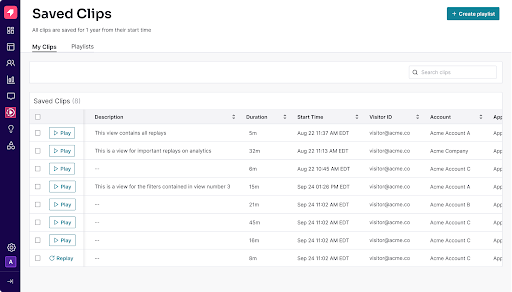“Do I really need a session replay tool?” 3 stories from those who thought the same
We’ve all heard the famous saying “A picture’s worth a thousand words.” But what about a video? Product teams are always on the hunt for ways to truly understand their users—and then build the best products for them. And one key tool to accomplish this is through visual replays of a user’s in-app experience.
As beloved as session replay tools are, getting buy-in from leadership (or budget approval) isn’t easy. That’s why we compiled three powerful stories about the impact of visual evidence, plus how to overcome compliance concerns.
Real-world stories about the impact of session replays
Session replay is more than just a visual recreation of your user journey. It’s a comprehensive solution that captures user interactions—like clicks, hovers, scrolls—and reconstructs them into a visual narrative of how users navigate an application. It’s your window into how users interact with your app when they’re trying to accomplish tasks.
As part of the Pendo One Platform, you can pair replays with product analytics, user feedback, and other qualitative data to understand what and why users do in your app. Here are three real-world ways you can make a positive impact on your business with replay footage:
1. Uncovering technical UX debt
All product people need to get their hands on replay footage and watch everything with friction to understand where users are struggling.
Here’s an example: Molly, a UX designer at Pendo, found that users were struggling with a date range selection feature. As she watched replays with ‘frustration indicators’ in them, she found that users trying to set date ranges in Pendo had to click many times to set dates that were far apart. Molly saw this, and was mortified.
By sharing a replay of this in Slack, Molly’s engineering team identified a simple fix. Within two hours, they implemented a solution that dramatically improved their UX! Great work, Molly and team!
2. Monitoring new feature launches
When you launch a new feature, replay footage can answer questions like:
- Do people use the feature like you imagined, or are users running into friction—like bugs you didn’t find in testing?
- Are users following the ‘happy path’ you had in mind? Are they using the feature in unexpected ways? Or are they dropping off entirely and going elsewhere?
- What types of customers or personas are having success, and which ones are struggling?
When Pendo launched AI-powered Suggested Replays, initial metrics were contradictory: Usage data was low, but user feedback (gathered via Listen) was positive. Our quantitative and qualitative metrics were helpful at telling us something was off, but we didn’t know what.
Our product team watched replays of users visiting the replay library and found something shocking: 70-80% of users were encountering an empty state instead of suggested replays! This guided our next product iteration, and we got to use three types of product data to guide our roadmap forward.
3. Validating product investments
During one customer conversation, a product manager shared that his leadership team wanted to focus on releasing new features. However, he knew that wasn’t the right direction to take based on user research and his adoption metrics. He showed those metrics to leadership, but they didn’t budge.
Upon watching replays, he quickly found the visual evidence he needed to push back: Users were stuck inside of a separate section of the product and spent roughly 80% of their time in-app U-turning between two pages.
Equipped with these replay clips and product usage stats like total time on page, his leadership team reprioritized their entire roadmap! Now, they’re focused on cutting users’ time on this workflow to 30%.

Facing compliance and privacy concerns?
We focused on giving you the right privacy and security options for your replay data, so you can do what’s right by your users and company.
Data privacy and security are common objections to session replay tools, which is why Pendo Session Replay lets you enable the right type of privacy for your needs:
- Maximum privacy. If your product handles a lot of personally identifiable information (PII), you can choose to block out as much data as possible. That way, when Pendo recreates sessions, you see stars as a placeholder and data doesn’t get passed along to Pendo (or you).
- Inputs only. If users only put PII into places where they type information, this security level blocks out what users type in so you can still see the navigation and topbars.
- Minimum privacy. This level of security is typical for websites and knowledge base articles. Emails, passwords, and phone numbers will be masked, but you can still see other elements of your product’s user interface (UI).
Once you pick a privacy option, you can choose to make things more (or less) granular. You can also select which user replays you want to capture by using our segmentation engine to capture certain user sessions and exclude the rest.
Expert tips to get more from session replays
If you’re not quite sure how to start using replay in your day-to-day workflow, look no further. These best practices will help you get the most from your replay footage:
1. Set up saved filters
First thing’s first, go to the library and set up a few saved filters of your product area or pages/features you’re actively working on. This should populate a few suggestions of areas you should pay attention to, so you can start watching replays to level-set what your CX is like. Then, you can proactively identify a few quick wins you can tackle to improve your product.

2. Contextualize insights
Set up dashboards that include saved filters so that you can keep track of qual, quant and visual all in one place.
For feature launches and future investments, you should set up Analytics funnels and Data Explorer (DX) reports, and launch replays from there to watch experiences in the context of important data.
3. Share replays with other teams
Many customers have had success bringing replays into their weekly meetings with engineering and Go To Market (GTM) teams. Pull up the saved filter during weekly meetings and watch a few replays live so everyone can see what they just spent weeks working on, in the wild!
This post is a recap of our recent webinar, Watch and win—how you can use Session Replay to build better products. Take a self-guided tour of Pendo Session Replay, or talk to an expert for a live demo.


